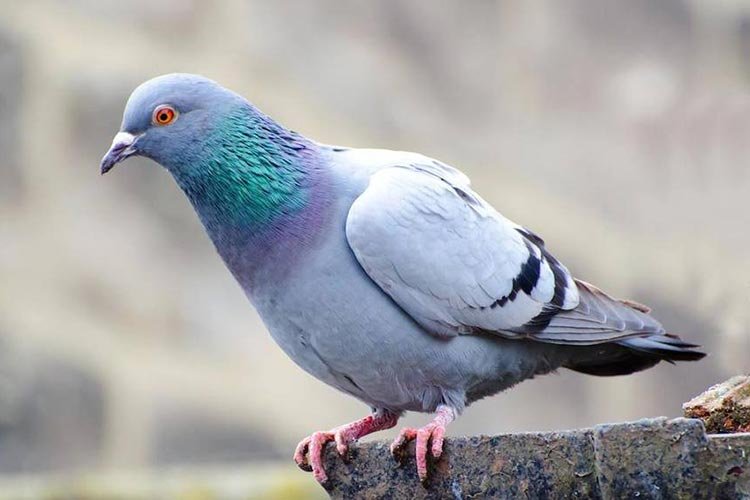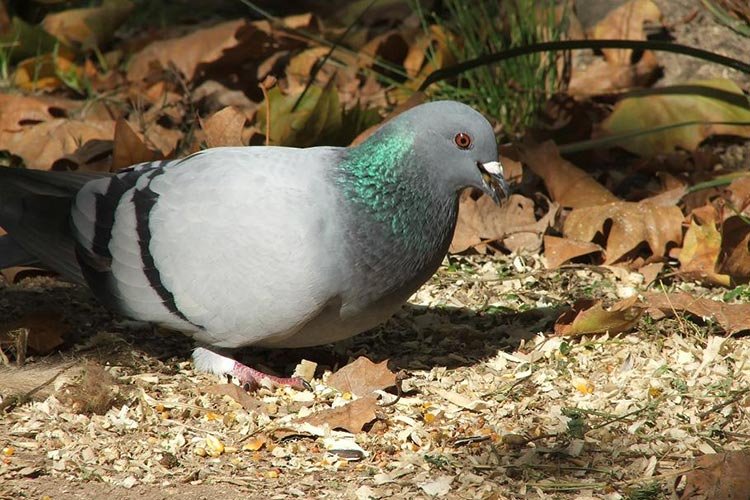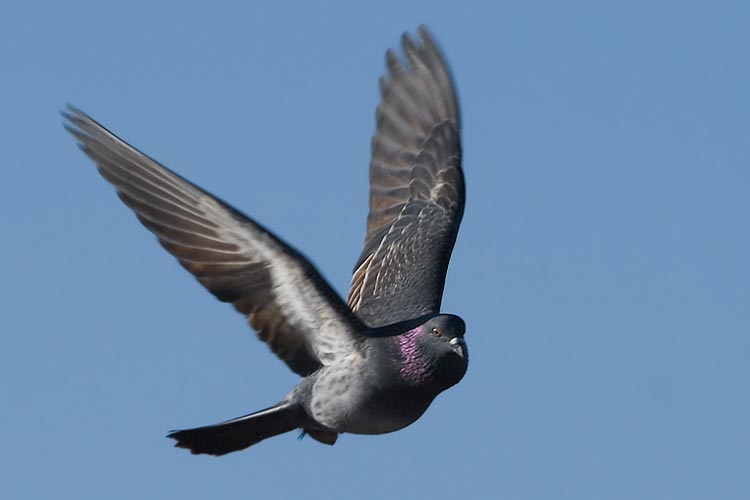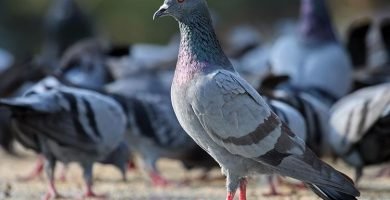
You can see dozens of pigeons in the streets every day. Some people love them, some other don’t… But some of who love these birds decide to keep a dove as a pet. Have you ever wondered if it’s simple to raise and take care of a pigeon?
Types of pigeons
What are pigeons like?
Pigeons have had a close relationship with humans for many years. A pigeon is usually 32 cm long from beak to tail, with a weight of 350 gr. This bird has been used as a carrier, as a symbol of peace and as a faithful companion for persons.
It’s an animal whose behavior is usually calm. The most commonly type seen in the cities is the rock dove, a species that many people believe that’s endangered due to the multiple crossbreeding it has suffered over the years.

Different to other animals, the pigeon is an animal that doesn’t represent a threat for human beings. When there’s food in between, they can be violent to each other or to other smaller birds.
Some others believe that they also have a very strong character. When someone feeds them, they like to chase that person in order to get more food. For this reason they’ve been banned from being fed in many cities.
Are doves and pigeons the same?
Many people think that when talking about pigeons and doves, we are talking about different birds. The truth is that doves and pigeons are the same bird, but the term are used somewhat interchangeably.
Is it advisable to raise several pigeons together?
In some countries, pigeons are reared in dovecots on top of some buildings. Although these have been disappearing in recent years.
Pigeons that grow up in captivity often don’t have the violent behavior of hurting other pigeons when trying to get food. However, some species of pigeons have a dominant gene, so it’s not surprising that when two species are crossbred, they end up in a conflict to each other.
But they don’t just fight for food. Two male pigeons may end up facing each other when trying to mate a female. Similarly, two female pigeons could fight to get the attention of a single male. So you have to be carefully when choosing the gender of the pigeon before putting them together in a cage.
How to tell the sex of a pigeon?
Not all birds are so easy to distinguish. In case of pigeons, you have to look at the genitals. Females have the exit of the left oviduct is larger, especially if they have previously laid eggs. In the case of males, they have two small red beaks in the area, 1 to 3 mm long. Mature female pigeons have slender bodies and narrower heads than males. The bodies of male pigeons are more robust. Males also have thicker necks and wider heads.
After laying eggs, it’s possible to determine the sex of the brood. Most of the time, the first egg that the female lays is male, with a success rate of no more than 50%. If the egg is more pointed at one end, it means it is male. The reason is that, as the former is the latter to be out, the expansion of the cloaca is more difficult, which originates this shape.
In the case of having a pigeon and not knowing its sex by the genitals, the two shanks can be joined together. If these are the same, it means that it’s a female, but if they are of a different length, it means that it’s a male.
When they’re newborn, it’s easier to tell their sex. According to experts, after seven days of life, the roundest chicks are the females due to their “sexuality”. But the most famous trick is to wait until the pigeon is three or four weeks old. Place the pigeon on your hand, holding its legs, and stretch it gently by the beak. In the case of lifting the tail, it’s a female, but if the tail is low, it’s a male. This system has a 99% success rate compared to other methods.
Males make longer sounds and open their tails in a semicircle at mating time, and females swell their plumage. But in terms of behavior, males often peck at the heads of females, which helps to distinguish them when they are in a large group.
All about the dovecotes and lofts
A pigeon should be raised in a loft, but not everyone has enough space for this. So they have to be reared in a cage, or a modular loft if you want to have different birds. However, if you have a large garden, you can build a large, home-made pigeon house so that you can keep all the birds in it.
In case of a single pigeon, a cage of 60 × 50 cm is enough, and 50 × 50 cm if it’s a newborn pigeon. They should have enough room to be able to move their wings. Although if you have enough space, a 100 × 60 cm loft is better for the dove to move around inside of it.
It’s necessary to place a grid that separates the different compartments, as well as on the floor and on the walls. The grids shouldn’t have large holes. It’s not that the pigeons are going to escape, but if the material of this one is not of a good quality, they may tear it little by little with the legs to try to escape.
Once you choose the pigeon cage, the interior should be decorated so that the pigeon feels comfortable inside. A lot of hangers are needed, as pigeons like to sit on them very much. It’s better to remove the ones that come in the cage, as they are not of a good quality. Instead, buy a flat hanger 6 cm long, another made of rope fabric about 2 cm in diameter and several wooden hangers. All of these must be located at different heights, so that the dove can exercise. Under no circumstances, you should put mirrors or reflecting objects inside the cage. It causes damages in the pigeons’ vision and makes them very nervous.
Near the cage, you can install an ionizer and air filter. It will help you collect the fine dust that the pigeons expel that can irritate people’s lungs.
Control the temperature
Placing the cage outside is the best choice, but whether you are at home or away from home, we recommend you to cover the floor with newsprint or something similar to help make the task of cleaning easier.
Pigeons are animals that live in warm temperatures, between 65 and 75 ºF. Therefore, you will have to install some device that allows you to control the temperature of the area where it is, so that it doesn’t die by cold or heat. In summer, a small fountain can be installed inside the loft to cool the pigeon. If there are several pigeons, then put at least two of them. But if the pigeons are trained, they can be removed and cooled off by themselves in a garden fountain, then they will return to the cage by themselves.
Pigeons breeding is difficult, as this will require to build a nest. There are many tutorials on the web, and you can even find artificial nests, but the best is to give the pigeons everything they need inside the loft so that they can make it themselves. To make the task easier for them, there should be a few bricks inside the loft, because it’s there where they will place their nest.
The water dispenser must be large, installed outside the cage, and with a large capacity so that the pigeon always has water. However, you will have to change the water often, especially in summer. Pigeons don’t like hot water.
Where to place a pigeon loft?
To find the right place for dove can be a real headache. If you only have one dove, place it in a quiet room where no one bothers. You have to leave her water and food for three weeks and stop every now and then to check how the pigeon is. Be careful not to disturb, because they’re easily stressed by being in an unfamiliar environment. After this time, you may already be able to make direct contact with it.
Once it’s used to human being, the best thing you can do is to place it in a room where social life can take place, so that it can interact. It should all be in an area where in the mornings there are sunrays, and warm at night so that it doesn’t get cold. One of the main causes of death in these animals is freezing.
Avoid placing them near lamps or TV, flashes from these devices are harmful to their eyes and the pigeon can become violent. In case of having other pets, take special care of the pigeon so that it cannot be reached by the others. There are many doves that get along with cats and dogs, but this usually happens when the pigeon has been in contact with them since birth.
If you’re planning to install a loft outside, look for an area that is neither too warm in the morning nor too cold at night. Put the necessary toys so that the pigeons can entertain. Avoid outdoor lamps too close or putting the loft near the roads. The sound of traffic can make it nervous.
What to consider when feeding pigeons
People believe that pigeons feed on breadcrumbs. It’s a bad habit created by humans for feeding these birds in the park. But the truth is, that it’s the last thing these birds should eat.
Domestic pigeons generally need to be fed a mixture of different types of cereals, legumes and oilseeds. Doves eat about 30 grams of grain per day, an amount that may increase during their breeding season. You have to be especially careful with the quantity, as pigeons tend to get fat quickly, so you have to increase the amount of feed to make sure it’s fair and necessary.
Like all animals, pigeons require a daily feeding. But if you cannot peed them every day, it’s better to make a small feeding system with which the pigeon can eat the right amount every day in the loft.

Keep in mind that doves go through many stages throughout their lives, especially if they’re bred with other birds of the same species. It requires to give special food at each stage of their life. Chicks are usually separated from their parents when they are 25 days old. It’s then when they begin to feed on grains. The problem is that they’re very vulnerable, so you have to make the feeders and water dispenser accessible. They may need help to eat for the first few days until they learn how to do it on their own.
What to feed pigeons with?
You have surely wondered what kind of food should be fed to pigeons. The main list for feeding pigeons is the following:
Cereals
Wheat is the main food for these birds, with a feed value of 76%. Wheat grains must be thick, regardless of their fat. In times when the pigeon has a lot of wear and tear, it is advisable to bet on this type of food.
The sorghum is the second on the list, with a food value of 80%. Don’t forget to include the barley in the doves’ diet, which has a nutritional value of 74%. It is also good to feed it with oats, with a nutritional value of 63,5%, since its minerals help it to stay healthy. From time to time it’s also good to feed them a little rice for its nutritional value of 82%.
Legumes
Although legumes cannot be the basis for pigeon feeding, they’re necessary because they are rich in proteins. It’s a substance that transforms and develops pigeon muscle and feathers. They’re especially necessary during the growth of chicks.
Beans and peas, with a feed value of more than 70%. Occasionally, it’s good to feed the bird one of these foods to help its digestive system function properly.
In case of choosing the carob tree to feed the pigeon, you should choose the grey ones, because of their small size. Lentils are also good for their nutritional value of 73,6%. The best is that they are brown, as they’re the ones that provide more nutrients to the doves.
Oilseeds
It should be used as a supplement and not as a food, since excessive consumption can affect the pigeon’s liver. But it’s important because of its great nutritional value.
Hemp, rapeseed and linseed can also be a good choice, with a nutritional value of more than 30%. All these should be given in small quantities. Pigeons don’t eat them well, despite how healthy they are. Consuming too much can cause digestive problems such as diarrhea. It’s also good to give them some small sunflower seeds.
How should pigeon feed be distributed?
Pigeons’ feeding will depend on their stage of life. If it’s a newborn, mix in 1 kg: 25% legumes, 30% corn, 25% wheat, 5% barley and 15% sorghum. Mix it and feed daily with no more than 30%.
As doves also need oilseeds to be healthy, 5% of them must be fed. Once the baby pigeons have grown up, the legumes can be increased to 40% of the total amount. If they’re in the process of weaning, it shouldn’t exceed 25% of the total.
At the end of the summer, they will start with the feather molt. Their diet should be composed of 25% legumes (especially beans and peas) with 65% mix of cereals and 10% oilseeds such as sunflower.
When winter is over, which means the end of their molt, their diet must be made up of 10% legumes, 80% cereals and 10% oilseeds. At this time of year it’s better to feed them once a day.
What other foods can be given to pigeons?
It’s true that we shouldn’t feed pigeons on bread, but there are other good for doves, because of their nutrients and minerals.
One of these is vegetables. In their natural state, pigeons are granivorous, but they also feed on vegetables. In this case, their diet is based on leaves, stems and some flowers. As they’re in captivity, you should give them at least once a week some fresh and chopped vegetables. It’s more common to feed them on lettuce or carrots, because they are the easiest to digest. Besides, they help prevent worms and weakening of their eyes.
Garlic, which has always been considered a food with multiple benefits, is also very good for pigeons. Because of its high content of sodium, sulphur and ether, it helps prevent heart, lung and blood pressure problems and fight against parasites. Just give them one clove of garlic, finely chopped, once a week.
The lemon, which is not usually recommended for many animals, but for pigeons. Especially when the pigeon is sick, you should give it, as the vitamin C it contains helps it to fight fatigue, cold or any other disease. It’s better to squeeze the lemon in the water so that the pigeons can drink it.
The honey is also good for the pigeons. It’s one of the most effective remedies to help treat diseases in pigeons, especially when they suffer from bronchial or throat problems. It’s a food that should be given to pigeons throughout the year, in small quantities, especially during the time of skin shedding so that their feathers look shiny.
Main pigeons diseases
The fact that the pigeon gets ill doesn’t mean that you’re a bad caregiver. Some doves may have inherited diseases or may have been infected by a virus. The most common pigeons diseases are:
- Paramyxovirus: This is a virus that infects pigeons. One of the main symptoms is that pigeons drink a lot of water, while they eat very little. Their droppings are too liquid and as time goes by, their wings and legs become paralyzed. They tend to walk backwards and become blind. It’s a deadly infection for pigeons.
- Salmonellosis: Also known as paratyposis. The pigeon suffers from an intestinal infection, although other organs such as the liver or kidneys are also affected. It especially affects newborn chicks that suffer from stunted growth or thinning.
- Trichomoniasis: Due to this disease pigeons lose their vitality and have little desire to fly. Their droppings are liquid and their throats are red. It’s a disease that can affect both adult and young pigeons.
- Ascaridiosis: During the disease, pigeons may have droppings of different consistency. Their appetite will increase at the beginning of the disease. It will progressively decrease due to the worms they will have inside. So we have to help them get rid of them.
- Smallpox: Smallpox develops from the passage from the outer skin to the mucosa in the eye and beak area, but can also occur on the legs. These smallpox should be avoided at all costs.
- Contagious rhinitis: The dove starts sneezing and leak from a nasal fluid that can be viscous and yellow-brown in more severe cases. Little by little it will lose the appetite and the desire of drinking water. It won’t shed the skin either, and it won’t fly. Besides, the pigeon will scratch its head and nose, keeping its beak open.
Should I let the pigeons loose at home?
Deciding whether or not to let the pigeon go around the house is an important decision. They get scared easily and even though they are used to being surrounded by people, they may not like moving around the house.
Because of its large size, it’s not as easy as letting loose a parakeet or any other small bird. It may feel overwhelmed for not having enough room to move its wings around in the room. If you’re going to take it off, it’s better to be outdoors, but with a small rope that connects it to you so that it doesn’t escape.
Having the pigeons’ trust is only a matter of time, so you have to be very patient.
How to train a pigeon
Training a pigeon is not impossible, but it requires a constant work. Especially if you are looking for it to participate in competitions.
To start the training a dove you have to wait for the first molt of the first primary feather of the wing. The first task is that the pigeon flies for one kilometer, joined by another pigeon that has already flown before. You have to repeat this process several times until it can do it alone.

Once completed the first task of the training, it’s time to double the distance, up to two kilometers. Even though the pigeon is used to flying alone, it’s good to do it with another one. The third time, the distance must be increased to 5 kilometers, alone or with another dove. The distance must be increased, always twice as the previous one, until it can cover 100 kilometers.
The number of times it covers the same distance is at the discretion of the trainer. Some pigeons learn quickly and don’t need to repeat the same distance several times. But with long distances, it’s better to do it little by little, especially the first time they are with another dove.
Are there any tricks to success? According to experts, there are a number of requirements to be met:
- One month before the training starts, the pigeon must have started to fly in the loft, about 10 minutes in the morning and 10 minutes in the afternoon, without stopping.
- Subsequently, in the 15 next days, the flying time must be increased to 30 minutes in the morning and in the afternoon.
- When it’s used to flying for this time, the loft must be opened for the pigeons to fly. They have to be fed when they come back.
- The best time to release the pigeons is at 7 am, and around 4 pm. You can vary the hours, but these are the best times of the day for them to fly out.
Mating and breeding pigeons
Although the best way for two pigeons to mate is to leave them to their own free will, if you want to manipulate the process, there are certain tricks that you can use.
The first thing to do is to choose a male and a female who have no defects that could affect the breed. Check that they are dewormed inside and outside. Once ready, they should be placed in a separate cage when they show signs of mating, such as the male running after the female or both stroking.
You have to prepare a nest for the male to be in it, and another one for the female. When the first signs of heat appear, the female should be placed in the male’s nest. If successful, within 8 days of mating the female will lay the first egg.
The pigeon will be born at 18 days, and it’s time to start working with it. Once it is 8 days old you have to put a ring on it, to differentiate it from the rest. After 22 days, it must be lowered to the ground in the morning and returned to the nest in the afternoon. After 23 or 24 days, the pigeon must learn to eat alone from the feeder, with some help from its breeder. It’s possible that the dove is still looking for its mother for feeding. It’s also a good idea to put it on the roof of the loft so that it can get to know what’s around it.
At 25 days of age it’s time to separate it from its parents’ loft and put it in the brood loft, where it will be during the day. In the afternoon the dove must be returned to its parents’ loft, so that they can help it feed. But if the bird is already able to feed itself, it can be moved permanently to the brood’s loft.
Between 30 and 35 days of age the pigeon must be able to leave the loft window by itself and return when it wishes to do so. It’s then when the training needs to start.

